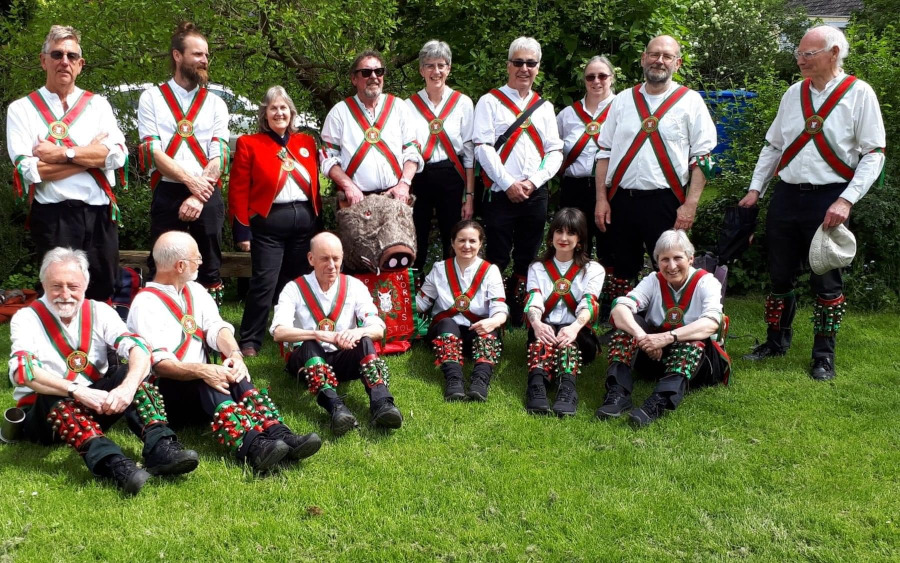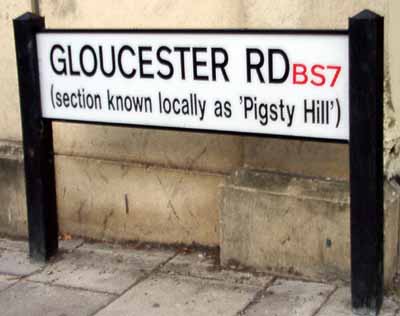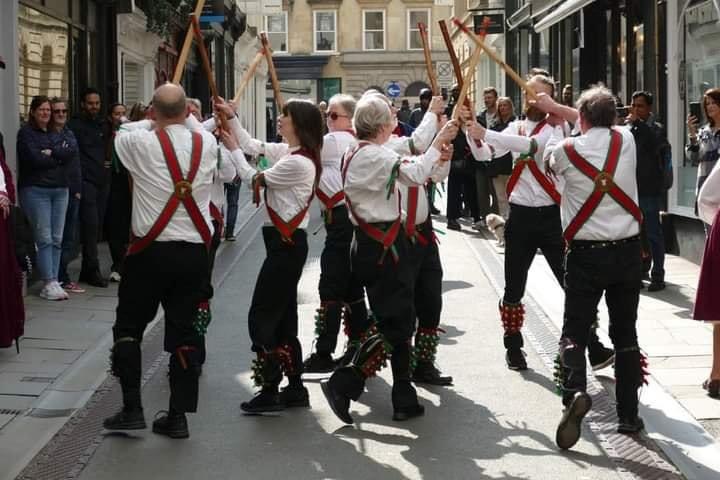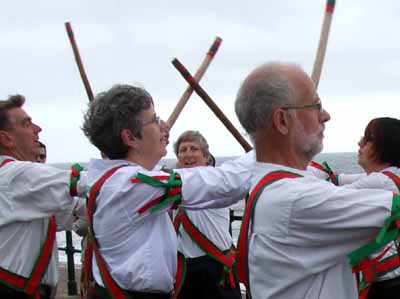We are a dance group based in Bishopston, Bristol, UK. Our dances are lively and energetic, designed to entertain and attract today's audiences, but with their roots in traditional English Morris dancing. We dance regularly in the Bristol area, but also perform at venues around the country and further afield.
 (Brandon Hill 04:30 at dawn!! Tues 01 May 2018)
(Brandon Hill 04:30 at dawn!! Tues 01 May 2018)
 ........
........
 ........
........
 ........
........
 ........
........
 ........
........
 ........
........
 ........
........

Morris dancing gives you a great opportunity to enjoy yourself while keeping fit, meeting other people, touring the country and getting involved in community events, festivals, street entertainment, television - you name it, Morris dancers have been there! Lots of people are natural dancers, but modern life may offer relatively few accessible dance opportunities - Morris is one. There are very few pastimes that combine a really good social life with a rewarding and challenging activity - the chance to travel and the option of getting involved in local events in your home area. Besides, if everyone knew about the free beer and the cut-price festival tickets...
 May 2023 Bradford-on-Avon Green Man Festival
May 2023 Bradford-on-Avon Green Man Festival
If you enjoy ceilidhs, barndances or other forms of dance, then Morris dancing could be for you. We welcome new adult dancers with any amount of (including no) experience.
Best to wear loose or stretchy clothing and trainers.
We are all vaccinated for covid-19. Weekly sub £3
-->
For more information:Contact 07508 216811 or pigstymorrisBristol@gmail.com
Most of the events we perform at are in the Summer months (see our Programme
for 2024 below). There's no such thing as a typical dance event. Every
year, we dance at all or most of the following. People choose the ones
they like and you can do as many or as few as you want: Local pubs - generally a relaxing Friday evening at a pub near Bristol - we know a lot of landlords and they welcome us every year. Festivals - these can be big
events, where we are centre-stage, or smaller, community events where we
just dance around the town. They can be anywhere in Britain - or
further afield. Fetes - usually organised by schools or villages - a chance to get to know local groups and enjoy the events they have organised. Morris weekends - organised by other Morris groups in their area (or by us around
Bristol) - an opportunity to see somewhere new, and meet old friends. Click here if you'd like to return to top of page, otherwise carry on reading... Most dancing takes place in the summer - our programme shows you our dance schedule for 2024. We're currently taking bookings for 2024. If you would like to book us for an event, see our booking details below
Sat 20 Jan 2024 Hillfields Fishponds Wassail. Hillfields Park, Thicket Ave. BS16 4EP. 13:00hrs Photo (Thanks Hillfields community garden)
Sat 20 Jan 2024 Horfield Orchard Wassail. Path by 22 Kings Drive BS7. 14:00-16:00hrs. Photo (Thanks Sean )
Sun 21 Jan 2024 Cancelled due to Storm Isha Woodcroft Community Orchard Wassail.
Feb 2024
Sun 4th Feb 2024 re-scheduled Woodcroft Community Orchard Wassail. 7 Woodcroft Rd Brislington BS4 4QW Photo
Mar 2024
Apr 2024
Tue 23 Apr 2024 Stoke Gifford Retirement village (private)
Tue 23 Apr 2024 George&Dragon Pensford 19:30
Sun 28 Apr 2024 University Botanic Garden 16:00 tbc
May 2024
Wed 01 May 2024 Brandon Hill dance at dawn 04:30
Wed 01 May 2024 Watershed for Noods Radio 18:30
Sat 11 May 2024 Bradford on Avon Green Man
Sun 26 May 2024 Chippenham Folk Festival (all day)
Jun 2024
Sat 01 Jun 2024 Weymouth Folk Festival all day
Jul 2024
Thu 25 Jul 2024 Portishead with Mendip Morris evening.
Aug 2024
Sep 2024
Oct 2024
Nov 2024
Dec 2024
We are always interested in dancing at any event - however big or small, and
wherever it is located. Apart from events like fetes and festivals, we have performed at social and charity events, danced in schools and old folks' homes, danced in Trafalgar Square, Bath Abbey and street parties, just to name a selection! Please contact us at pigstymorrisBristol@gmail.com to see if we are available for your event, or ring 07508 216811 if you don't have e-mail access. We like as much notice as you can give us - so contact us now to avoid disappointment! Horfield community orchard apple day Jan 2023( Photo John Mildenhall) Morris dancing is a general term for any
of many sorts of traditional English ritual dance. The earliest records
of Morris dancing are only a few hundred years old, though some would
have you believe that it's definitely pagan. There are many theories
regarding its origin - generally tenuous in nature. Whatever the origins
of Morris are (and we may never know), the most important thing is that
it does not become preserved as a 'museum piece', but lives and
continues to evolve. Of the many forms of dance, Pigsty Morris dance
Cotswold Morris - which is characterised by vigorous movements,
accentuated by the waving of handkerchiefs, the clashing of sticks, and
the ringing of bells tied to the legs. Much of the Morris dancing you
see in Britain today has developed from the material collected about a
century ago, which itself had evolved over centuries before that. The
collected material made Morris widely accessible, and it spread from the
people and areas where it had traditionally been performed. Without
this revival, it is quite possible that English Morris would have died
out completely. As regards women dancing (as they do with Pigsty Morris
and in many other groups), there is evidence that women danced the
Morris during the 1800s (as they may have also done before that time),
and they were pivotal in its revival in the early 1900s. The widely held
stereotype of the Morris dancer as a middle-aged, beer-swilling man has
probably only developed since then, as Morris dancing between 1920 and
1970 was very much a male preserve. Hopefully the stereotype is fading;
nowadays, men and women of all ages and backgrounds and from all walks
of life take part in and enjoy Morris dancing. ps Most famous Morris
dancer was Joseph Needham (1900-1995) Author of 24 vols of 'Science and
Civilisation in China'. If you would like: * information about Morris dancing in general contact pigstymorrisBristol@gmail.com, For some other Morris groups around Bristol, see
Rag Morris (mixed group-Thursdays),
Bristol Morris Men (Men-Thursdays)
Winterbourn Down (mixed group-Mondays) and
nonesuchmorris (mixed group-Wednesdays) (We at Pigsty Morris are mixed and practice Fridays)
Kittiwake border morris (mixed group-) (We at Pigsty Morris are mixed and practice Fridays)
For general Morris information, see the Morris Federation, the Morris Ring and Open Morris And for something completely different, try Kelvin Players - the theatre group whose hall
or even Swedish folk dance Swedish folk dance/music
23 April 2023 15:00 The Old Green Tree in Bath, with Somerset Morris (St Georges Day) Photo (Thanks John M)
Sat 14th Jan 2023 Wassail: Horfield Organic Comunity Orchard (BS7 8JP) Photo (Thanks John M)
Photos/video 2016-2022
Sun 25 Sep 2022 Ashley Hill Allotment/ St Werburghs city farm allotment show 12:30pm. Photos thanks Kath and Sean
Thurs 9th Jun 2022 Stoke Inn, Chew Stoke (70th jublilee celebration). Photo thanks Sean
Sun 29th May 2022. Chippenham folk festival all day. Photos thanks John Mills and Sean
Sat 30th April 2022. Bristol Folk Festival. Afternoon Photo thanks Sean
Aug-Oct 2020 Covid-19 dance and zoom 2 Photos
Tues 01 May 2018 Brandon Hill 04:30 at dawn!! Photo
Sat 21 Jan 2017 Bedminster wassail. Photo
Photos/video 2014/15
18-Jan-2014 Horfield Organic Comunity Orchard Wassail two Photos (Thanks Kath) (rag jacket kit)
04-May-2014 Bristol Folk Festival afternoon Photos (Thanks Sean)
31-May-2014 Wessex Folk Festival (Weymouth) Photos (Thanks Sean)
01-Jun-2014 Wessex Folk Festival (Weymouth)cont.photos link to flickr
06-Jun-2014 Boars Head Aust 7:45 for 8pm Photo (Thanks Sean)
27-Sep-2014 Stroud Folk Festival. Dancing in Stoud centre. Photo (by Tony Quigley)
01-May-2015 Dance at dawn (04:30 on) on Brandon hill Bristol with other sides. The two primary schools (private) Photo (Thanks Deb)
03-May-2015 Bristol Folk Festival. 12:00 Folk House, 12:45 St Georges, 15:00Corn Street.Central Bristol. Richard Toller's photos
09-May-2015 Horfield Community Orchard Spring Fair after 2pm Photo (Thanks Lucy Mitchell)
12 to 14-Jun-2015 Wimborne Folk Festival. Steve and Helen Jones dance photos
19-Jun 2015 the Druids Arms pub Stanton Drew 8PM Photo
Photos/video 2012/13
14 Apr 2012 Our Day of Dance with nine other local and distant sides. Bristol city centre approx times:
Galleries youtube link
Centre Promenade youtube link
27 May 2012 Breast cancer charity event in Locking 3 photos
Photos/video 2010/2011(red/green belt kit)
16 Jan 2010 wassail at Horfield allotment One Photo (rag jacket kit)
10 Apr 2010 Barton Hill Settlement Bristol. First photo in 2010 kit
23 Jul 2010 - Anchor at Oldbury 10 mins YouTube: Vandals Lolipop and London Pride (Rag)
17 Oct 2010 - Apple Day. Horfield Organic Community Orchard photo
Photos/video from 2009 (red/green trouser kit)
Note: videos below not recommended on dial-up
Ring O Bells Pub, Priston, Bath new years day
John M party
Cardiff Ladies day of dance
3 dawn photos 1 May!
YouTube Redland fair:Pigsty Grenadiers Vandals of Hammerwich Saturday Night
YouTube DoD Glory of the West- Exeter Widders-Chepstow
YouTube DoD Pigsty (Fieldtown Trunkles) (Lollipop Man) (Bluebells)
YouTube DoD Pigsty (Three Jolly Sheepskins) and Widders
YouTube DoD Pigsty (Saturday Night)
Horfield Allotment Orchard Apple day
Filton College Wise Campus 2pm
Photos 2008(original kit)
3 photos Sat 7 Jun Wessex Folk Festival Weymouth
1 photo Sat 28 Jun 'Ragged and Old' day of dance, Near Stroud
youtube: Basque Dance (lichfield) at Kings Head. Ragged and Old DoD
66 Photos. Sat 13 Sep Glory of the West' day of dance, Nr Exeter
Photos 2007(original kit)
3 photos from Day of Dance in Bath with Priston Jubilee Morris
3 Photos from Two Rivers folk festival in Chepstow
Photos 2006(original kit)
8 Photos from Cardiff Ladies' Morris Weekend of Dance
1 Photo from Eastville Park garden opening
1 Photo from Clifton Street Party
1 Photo from charity event on Frenchay common
3 Photos The Fox, Old Down, with Rag Morris and Winterbourne
1 Photo of Weekend of dance with Ironmen and 7 Guilders
Photos 1987-2006(original kit)
20 'yearbook' photos 1987-2006
Photos from previous website
6 photos
Location: Kelvin Players Hall
 which is at 'Pigsty Hill', Bishopston, Bristol BS7 8NY Map
which is at 'Pigsty Hill', Bishopston, Bristol BS7 8NY Map
Corner of Gloucester Road (A38) and Wesley Road,
numerous buses to 'Hatherley Road' stop from south or 'Nevil Road' stop
from north. Bikes can be left inside.
 Apr 2023 Old Green Tree Pub Bath. Photo Marcus Good
Apr 2023 Old Green Tree Pub Bath. Photo Marcus Good
Jan 2024  by Steve and Helen Jones 2015
by Steve and Helen Jones 2015
Bookings

 One of earliest paintings:Detail from 'Dixton Harvesters' 1720 Anon, Cheltenham Art Gallery and Museum
One of earliest paintings:Detail from 'Dixton Harvesters' 1720 Anon, Cheltenham Art Gallery and Museum
* to talk about joining us or other groups
* to enquire about booking us for any event
ring 07508 216811.
 2013
2013
we've practiced in for all these years...





Image Archive
Photos/video 2023-
Sat 13 May 2023 Bradford on Avon Green Man festival - all day Photo (Thanks John M)
